Services on Demand
Journal
Article
Indicators
-
 Cited by SciELO
Cited by SciELO -
 Access statistics
Access statistics
Related links
-
 Cited by Google
Cited by Google -
 Similars in
SciELO
Similars in
SciELO -
 Similars in Google
Similars in Google
Share
Ciencia y Tecnología Agropecuaria
Print version ISSN 0122-8706
Corpoica cienc. tecnol. agropecu. vol.19 no.1 Mosquera Jan./Apr. 2018
https://doi.org/10.21930/rcta.vol19_num1_art:609
Economy and rural development
Interaction management in rural innovation processes
1 Doctorate student, Universidad Autónoma Chapingo (UACh), Centro de Investigaciones Económicas, Sociales y Tecnológicas de la Agroindustria y la Agricultura Mundial (Ciestaam). Texcoco, Mexico. Email: eroldan@ciestaam.edu.mx. orcid.org/0000-0001-8824-1201.
2 Researcher Professor, Universidad Autónoma Chapingo (UACh), Centro de Investigaciones Económicas, Sociales y Tecnológicas de la Agroindustria y la Agricultura Mundial (Ciestaam). Texcoco, Mexico. Email: rendon.roberto@ciestaam.edu.mx. orcid.org/0000-0001-8703-8041.
3 Associate Researcher, Centro Internacional de Mejoramiento de Maíz y Trigo (Cimmyt). Texcoco, México. Email: c.camacho@cgiar.org. orcid.org/0000-0002-2908-5357.
4 Research Professor, Universidad Autónoma Chapingo (UACh), Centro de Investigaciones Económicas, Sociales y Tecnológicas de la Agroindustria y la Agricultura Mundial (Ciestaam). Texcoco, Mexico. Email: jaguilar@ciestaam.edu.mx. orcid.org/0000-0002-6129-7050.
Product innovation, production and marketing, results from the interaction among several actors. Thus, the hub extension model of the governmental program MasAgro seeks to be a space in which farmers, extension workers, input suppliers, government, teaching and research institutions, among others, interact with each other to generate individual and collective well-being through innovation. The aim of this work was to analyze the relational structures within the hubs. For this, we carried out direct interviews to 457 actors from 10 agroecological regions that comprise the hubs of the maize system in Mexico. Measurements recorded are density, closeness, transitivity, and relationships diversity indicators; and twice during the analysis: baseline and final line, through the social networks analysis methodology. A “t” test of related samples revealed that for the first three indicators, there is a statistically significant difference between the moments in time the analysis was carried out (p < 0.05). This indicates that in the hub the interaction between the actors have been managed, and has become a space in which local structure has been generated and relational capital has been maintained; and these are the basis of social capital necessary for the development of innovation processes in the rural sector. These findings can be useful for program managers and policy makers as a complementary tool for evaluating intervention strategies in the sector.
Keywords: Agricultural sector; extension activities; hub; innovation; technology transfer
La innovación, producción y comercialización de un producto resultan de la interacción de una diversidad de actores. Así, el modelo de extensión hub del programa gubernamental MasAgro busca ser un espacio en el que agricultores, extensionistas, proveedores de insumos, instituciones gubernamentales y de enseñanza e investigación, entre otros, interactúen, con el fin de promover bienestar individual y colectivo a través de la innovación. El objetivo de este trabajo fue analizar las estructuras relacionales dentro de los hubs y, para tal efecto, se aplicaron entrevistas directas a 457 actores de 10 regiones agroecológicas que conforman los hubs del sistema del maíz en México. Se midieron los indicadores de densidad, cercanía, transitividad y diversidad de relaciones, en dos momentos de análisis: línea base y línea final, mediante la metodología de análisis de redes sociales. Una prueba “t” de muestras relacionadas reveló que en los tres primeros indicadores existe una diferencia estadística significativa entre los momentos analizados (p < 0,05), lo que indica que en el hub se ha gestionado la interacción entre los actores, y que se ha convertido en un espacio en el que se ha generado estructura local y se ha mantenido el capital relacional, que constituyen las bases del capital social necesario para el desarrollo de procesos de innovación en el sector rural. Estos hallazgos pueden servir a responsables de programas y diseñadores de políticas como una herramienta complementaria de evaluación de estrategias de intervención en el sector.
Palabras clave: extensión; hub; innovación; sector agrario; transferencia de tecnología
A inovação, produção e comercialização de um produto resultam da interação de uma diversidade de atores. Assim, o modelo de extensão hub do programa governamental MasAgro pretende ser um espaço no qual agricultores, extensionistas, fornecedores de insumos, instituições governamentais e de ensino e pesquisa, entre outros, interajam com o objetivo de promover bem-estar individual e coletivo por meio da inovação. O objetivo deste trabalho foi analisar as estruturas relacionais dentro dos hubs e, para isso, foram aplicadas entrevistas diretas a 457 atores de 10 regiões agroecológicas que conformam os hubs do sistema de milho no México. Foram medidos os indicadores de densidade, proximidade, transitividade e diversidade de relações, em dois momentos de análise: linha base e linha final, mediante a metodologia de análises de redes sociais. Um teste “t” de amostras relacionadas revelou que, nos três primeiros indicadores, existiu uma diferença estatística significativa entre os momentos analisados (p < 0,05), o que indica que, no hub, tem-se promovido a interação entre atores e se convertido num espaço no qual se tem gerado estrutura local e mantido o capital relacional, que constituem as bases do capital social necessário para o desenvolvimento de processos de inovação no setor rural. Estes achados podem servir como uma ferramenta complementar de avaliação de estratégias de intervenção no setor para responsáveis por programas e desenhadores de políticas.
Palavras chave: extensão; hub; inovação; sector agrícola; transferência de tecnología
Introduction
The rural and fishing sectors in Mexico are characterized by having an unsustainable development, with among other main causes: 1) agricultural and fishing activities with low growth; 2) poverty of rural families; 3) degradation of natural resources; 4) unfavorable economic environment; and 5) a weak institutional framework (Organización de las Naciones Unidas para la Alimentación y la Agricultura [United Nations Food and Agriculture Organization, fao] & Secretaría de Agricultura, Ganadería, Desarrollo Rural, Pesca y Alimentación [Sagarpa], 2012).
In this sense, the technological innovations momentum becomes relevant, since it is presented as an explanatory variable for economic growth for companies, regions, and countries (Fundación Cotec para la Innovación, 2001; Nelson & Winter, 1982; Sanz-Menéndez, Fernández-Carro & García, 1999; Schumpeter, 2003) or, in this case, of an agricultural, livestock or forestry system.
Innovation, understood as “any change based on knowledge that generates wealth” (Fundación Cotec para la Innovación, 2007), is the result of a networking process (Klerkx, Hall, & Leeuwis, 2009; Radjou, 2004). Therefore, product innovation, production and commercialization cannot be carried out by a single company, but in collaboration with other agents, because of their interaction (Edquist & Johnson, 1997; Koch, 2004; Koschatzky, 2002). According to Jasso (2004), by interacting, agents share knowledge and skills, which contribute to development and diffusion of new technologies, creating an innovation environment.
Moreover, innovation requires a management process (Lundvall, 1992; Observatorio Virtual de Transferencia de Tecnología [ovtt], 2016; Pavón & Hidalgo, 1997) and, in general, the term refers to the use and direction of human and economic resources to generate ideas that become innovations that can produce individual and collective well- being. In this work, we understand innovation management as knowledge management for the development of changes focused on value generation.
According to Rodríguez-Espinosa, Ramírez- Gómez and Restrepo-Betancur (2016), innovation management is an important element in current rural extension and focuses on three important activities: demand and supply articulation, networks composition, and innovation process adminis- tration (Howells, 2006; Klerkx et al., 2009; Van Lente, Hekkert, Smits, & Van Waveren, 2003).
However, network composition and administration activities in innovation processes needs external actors in production system in order to favor the establishment of new productive relationships (Klerkx, Aarts, & Leeuwis, 2010), as these will contribute to knowledge distribution and increase absorption capacities of different actors included in the system (Sanz-Menéndez et al., 1999).
Interaction management, as an exchange and commu- nication vehicle among actors, acquires relevance. In this sense, Robinson, Pawlowski and Volkov (2003) define it as a “set of activities directed towards the discovery, management and provision of critical relations among system sets”.
Applying this concept to the sector, López-Torres (2013) characterizes it as “the tactics that an agent of change can follow to make the actors of a network interact in the social field, exchange technical knowledge or create links to improve their marketing, technology transfer and innovation processes”.
Therefore, the interaction management as a tactic to favor innovation requires two important elements: 1) number of relationships, and 2) quality of the relationship (Rendón-Medel, Santoyo-Cortés, & Aguilar-Ávila, 2013).
Hence, the quantity influences the network’s local structure, i.e. in configurations and properties of subgroups of actors and their relationships (Faust, 2006), and in relational capital quality (De Castro, Alama-Salazar, López-Sáez, & Navas-López, 2009; Martínez-Torres, 2006). In other words, the value that a set of relationships (that an actor maintains with agents of its environment) has; this capital serves as knowledge and source of information for the company.
In this study, the relational capital refers to the fact that an actor, belonging to a certain group, e.g. a farmer, who relates to other farmers as well as to other actors of different groups, as extension agents, teaching institutions and input suppliers, among others.
However, the quantity and quality of the links created between the actors of a network establishes their innovation level. Furthermore, Rendón-Medel et al. (2013) argue that they are the basis for the creation of social capital necessary for innovation processes to occur naturally.
Considering this context, the hub model used by the program Modernización Sustentable de la Agricultura Tradicional (MasAgro) [Sustainable Modernization of Traditional Agriculture program], and led by the International Maize and Wheat Improvement Center (Cimmyt), seeks to be a space for different actors to work together on sustainable solutions in maize and wheat systems. Actors can be farmers, extension agents, input suppliers, governmental, teaching and research institutions, among others, that participate in the value chain of a particular agroecological region (Camacho-Villa et al., 2016), to generate individual and collective well-being through innovation.
Nevertheless, the concept of hub is applied in different knowledge areas, but in this case, Deschamps-Solórzano, Gómez-Luengo, León, Barila and Vázquez (2016), mention that the innovation hub or node is characterized by showing:
(...) an infrastructure of platforms, demonstration modules and extension areas in which participatory developmentprocessesarepromoted(identification, validation and dissemination) of sustainable MasAgro technologies, adapted to an agroecological zone and to specific needs and demands in different producer levels.
In this sense, this type of infrastructure interacts with a variety of actors, which supports the innovation process. Nonetheless, the management of the interaction in the hub model is mainly used in participatory development processes of sustainable technologies, which involves platform development, demonstration modules and extension areas.
According to Deschamps-Solórzano et al. (2016), the platforms are tested and traditional farmer practices are compared with practices or systems promoted by MasAgro, which are developed and adapted to the conditions and problems of their area of influence; these are prime spaces for training, knowledge facilitation, information dissemination and technology transfer.
In demonstration modules that are in charge of leading farmers, the technologies that are generated in platforms are tested, integrated and adapted. Farmers share their experience with their peers in these spaces through demonstration events, knowledge exchange tours, information distribution or communication from producer to producer. Finally, in farmer plots or extension areas, all what has been learned in these modules is put into practice (Deschamps-Solórzano et al., 2016).
It is necessary to mention that, both in demonstration modules as well as in extension areas, farmers and extension workers work together and, in addition, they generate links with government officials, teaching and research institutions, and input suppliers (seeds, fertilizers, credits and equipment, among others) (Deschamps-Solórzano et al., 2016).
The hypothesis that guides this work is that, as hubs are spaces for innovation management, these have increased both the quantity and the quality of the network relationships, which favors an improvement of relational capital and local network structure in the regions that comprise the model.
Thus, the aim of this study is to analyze the changes in the relational structures that comprises the hubs, before and after an intervention process, to demonstrate the impact that the model has in terms of interaction management.
Materials and methods
Information origin
A semi-structured survey was applied to the actors that comprise the hub: farmers, extension agents, teaching and research institutions, input suppliers and government institutions, among others. Four hundred fifty-seven (457) actors were analyzed in 10 agroecological regions (figure 1) in the analyzed hubs (table 1).
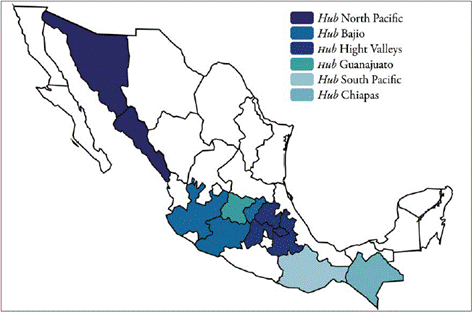
Source: Prepared by the authors
Figure 1 Locations of the agroecological regions that comprise the hubs assessed in this study.
Table 1 Number of actors included in the network and interviewed per agroecological region and hub
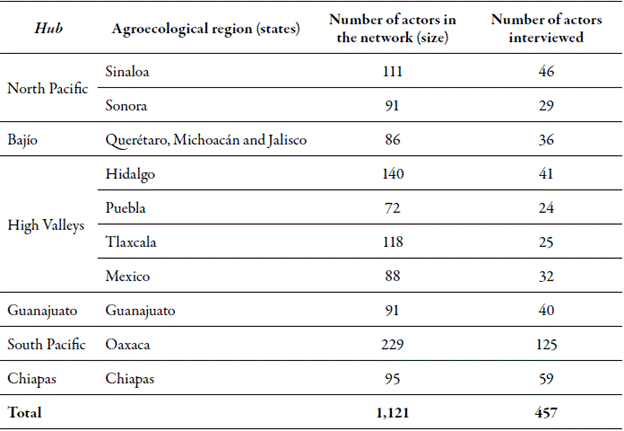
Note: In the case of Bajío, the analysis grouped three agroecological regions that comprise the hub.
Source: Prepared by the authors based on information from surveys conducted between 2015 and 2016
The number of actors interviewed obeys to direct non-probabilistic sampling. Surveys were applied by technical staff at Cimmyt, from October 2015 to October 2016. The survey comprised of two parts: in the first part, the identification of the actor was considered: name, age and the institution to which he/she belongs; in the second part interviewees were asked about their relations to MasAgro, i.e. who they deal with regarding technical aspects on sustainable maize and wheat practices, and year they started doing this. It is worth mentioning that actors interviewed were free to mention all those actors they remembered at the time of the interview.
Information analysis
Social network analysis (sna) was used for data analysis, based on the premise that social actors are independent and that the links established among them have important consequences for each one (Freeman, 2004); moreover, it uses a mathematical technique to analyze relationships between actors, as well as patterns and implications of those relationships (Wasserman & Faust, 1994).
In innovation management processes, sna is a tool that allows studying the structures that are formed before and after an intervention process (Aguilar- Gallegos et al., 2017; Díaz-José, Rendón-Medel, Aguilar-Ávila & Muñoz-Rodríguez, 2013; Sánchez- Gómez, Rendón-Medel, & Cervantes-Escoto, 2016).
Moreover, to capture relational information a catalog in which unique keys were assigned to each actor was used. The relational file was initially processed in the NetDraw program (Borgatti, Everett, & Freeman, 2002), to obtain the visual representation of the network, and then it was exported to the program Ucinet 6.288 to carry out subsequent indicator analyses.
The analysis considered two moments: 1) before the implementation of the hub in the region (LB) and 2) after its implementation (LF). Taking into account that the hubs began operating in the agroecological regions at different times, the years of analysis vary for each one (table 2).
Table 2 Year (moment) in which the analyses (before (lb) and after (lf) the implementation of the hub) were carried out per agroecological region
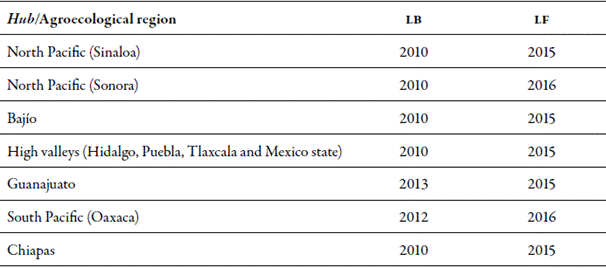
Source: Prepared by the authors, based on information from surveys conducted between 2015 and 2016
Moreover, the relationships that were considered as LB correspond to all those that already existed in the year the hub was implemented in the agroecological region. This means that in each of the analyzed territories there were already a certain number of relationships already established.
Furthermore, the quantity and the quality of the relationships are established with density and diversity indicators, and the local structure where triads, transitivity and proximity censuses were carried out. For a better comprehension, indicators are explained below:
Density
Refers to the proportion of all existing relationships compared to the ones that can possibly occur within a network (Wasserman & Faust, 1994).
Triad census
A triad is a set of three actors with possible relationships between the three (Wasserman & Faust, 1994), and a triad census summarizes the local structure of a network (Faust, 2006). Based on the types of triads defined by Holland and Leinhardt (1970), authors as López-Torres (2013) proposes three progressive levels in rural sector networks in order to favor innovation transfer (figure 2).
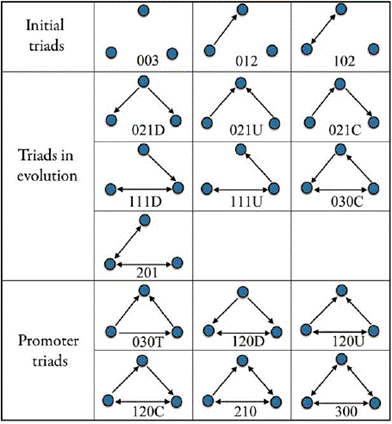
Source: Holland and Leinhardt (1970), adapted by López-Torres (2013)
Figure 2 Classification of triads according to their potential to favor the technology transfer and innovation.
According to López-Torres (2013): i) initial triads do not favor communication between actors and are found in widely dispersed networks; ii) triads in evolution are the most common ones found in rural sector local networks, and receive this name because they are in the middle of the technology transfer process. Finally, iii) promoter triads are ideal for transferring technology and innovation.
Transitivity
It is the number of transitive triads divided by the number of triads that meet the conditions to be transitive (Faust, 2006). Holland and Leinhardt (1970) argued that “interpersonal relationships tend to be transitive if actor A chooses B and B chooses C; then, it is likely that A chooses C”.
Diversity in relationships
A network has mutually exclusive groups with their own characteristics and, therefore, diversity of relationships is an index that is calculated by subtracting the number of internal links from the group to the number of their external links, and dividing it by the total number of links (Krack- hardt & Stern, 1988).
In this case, the variable that was used to divide the groups was the function of each of the actors in the network, i.e. whether they are farmers, extension agents, government, teaching and research institutions, or inputs suppliers, among others.
Figure 3 indicates that values close to -1 represents equality in relationships (homophily), and those that approach 1 represent diversity in relationships between groups (heterophily).

Source: Prepared by authors, based on Krackhardt and Stern (1988)
Figure 3 Diversity of relationships scale.
Closeness
Measures the geodetic distance between the actors in the network; in addition, greater closeness values indicate shorter distances and times, as well as lower communication costs (Freeman, 1978).
Once the base was generated, a “t” test was applied in related samples to measure changes in density indicators, diversity of relations, transitivity and closeness. Subsequently, with the values obtained from the indicators of the final lines, a Pearson’s correlation test was applied, in order to evaluate the structures and relational capital of the hubs analyzed. The average closeness indicator was used as a reference to establish quadrants. This analysis was carried out with the SAS program for Windows version 9 (Statistical Analysis System [SAS], 2004).
Results and discussion
Regarding the relational capital of the networks, the diversity value showed a slight decrease (from 0.43 to 0.41) at the time these were analyzed; this implies that they statistically remain as heterophilic networks (table 3). The persistence of heterophilia in the network is because the hub is a space in which a diversity of actors interact, i.e. farmers, extension agents, input suppliers, and governmental, teaching and research institutions.
These actors can be classified as internal or external to the innovation (Sánchez-Gómez, Rendón-Medel, Díaz-José, & Sonder, 2016), since it is based on the fact that in a network there are mutually exclusive groups (Krackhardt & Stern, 1988). Largely, the success of the hub model depends on the links that are made between these actors.
According to Corsaro, Cantù and Tunisini (2012), these interactions allow obtaining information regarding new production ways, as well as services support and external backstopping. While we cannot say that hubs have improved the relational capital in the analyzed regions, it has worked perfectly well as a platform in which constant interactions are promoted.
Changes generated in density, proximity and transitivity indicators are shown in table 3. In this sense, mean comparisons show significant differences in indicators in relation to the moments analyzed. Nonetheless, an increase in density value refers to more saturated networks. This result coincides with the work published by Aguilar- Gallegos et al. (2017), who after an intervention in a goat system, found that density values ranged from 1.18 % to 1.82 %. On the other hand, Sánchez- Gómez, Rendón-Medel and Cervantes-Escoto (2016) identified a change from 0.56 % to 1.08 % after an intervention process with sheep farmers.
Table 3 Changes showed by indicators per analysis moment

Note: The figures identified with * have a p < 0.05. N: Number of observations (per region); lb: before the implementation of the hub in the region; lf: after its implementation.
Source: Prepared by the authors, based on information from surveys conducted between 2015 and 2016
According to Coleman (1988), denser networks favor trust and rules among actors, since they facilitate the application of more effective sanctions among them. In addition, density influences transitivity and closeness values.
Díaz-José et al. (2013) mention that the effect of significant transitive triads points out to the existence of a network closure and represents an increase in relationships among actors; thus, promoting a greater information flow in innovation processes, which translates towards the creation of social capital. Likewise, Burt (2000) mentions that the social capital metaphor refers to the fact, that when people are better connected, the results obtained will also be much better.
Further, according to López-Torres (2013), the ideal triads for transfer of technology and innovation would be, in order of importance: the promoters, the ones in evolution, and finally the initial ones. In this sense, figure 4 shows the changes that occurred between the moments analyzed. In this regard, all regions showed a decrease in initial triads and an increase in the ones that are in evolution an in the promoters, although in the latter it was lower.
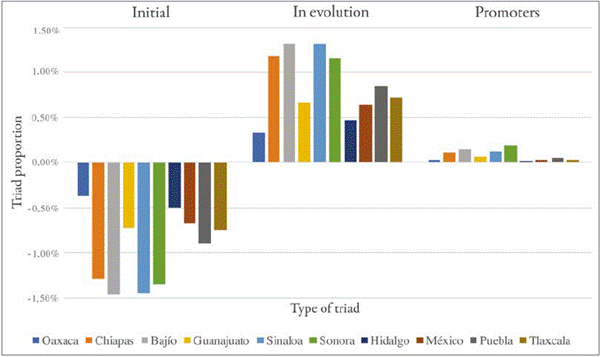
Source: Prepared by the authors, based on information from surveys conducted between 2015 and 2016
Figure 4 Changes in the proportion of triads according to their potential to contribute to innovation within networks in agroecological regions that comprise hubs.
Although, the initial triads are still the ones with the highest proportion in the networks (98.9 %), the change that occurred in the ones that are in evolution and the promoters regarding the moments in which they were analyzed is relevant. This is because, as mentioned by Gómez-Carreto, Zarazúa, Ramírez-Valverde, Guillén-Cuevas and Rendón-Medel (2016), this type of triads could contribute to information exchange, as well as to the development and strengthening of technological capabilities.
Therefore, these processes are already taking place in the hub networks. In addition, significant increase in transitivity value (table 3) indicates a greater possibility of a transition from the evolving triads into promoter triads. However, Faust (2006) states that this probability depends on the size and density of the network.
The correlation analysis carried out with the final lines (table 4), shows a link between diversity of relationships and closeness of the network, with a very strong degree of association, a level of significance p < 0.05, and a positive relationship. In other words, the closeness that exists in a network increases as the value of the diversity of relationships is positive or if the networks tend to be heterophilic.
Table 4 Correlation between indicators and level of significance

Note: *p < 0.05; N = 10
Source: Prepared by the authors, based on information from surveys conducted between 2015 and 2016
The relationships showed in table 4 suggests that in the regions analyzed there have been relations that, as Sánchez-Gómez, Rendón-Medel, Díaz-José et al. (2016) mention, they offer on one side social support and a motivation source (linkage with internal actors) for innovation, and, on the other side, they provide specialized services needed for production (linkage with external actors).
Similarly, current proximity indicator values show greater accessibility to the relational capital within the network, since, according to Freeman (1978), they showed shorter distances and times and lower costs when communicating (table 3).
Figure 5 shows the position of each of the regions that comprise the hubs according to their level of diversity of relationships and closeness within the network. This figure shows that the regions that comprise the high valleys and the north Pacific hubs behave very similar; this suggests a similar way to manage relationships, plus the fact that these have similar conditions, i.e. they are the only hubs that groups several agroecological regions.
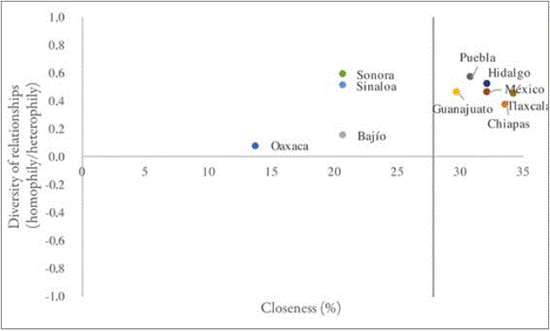
Source: Prepared by the authors, based on information from surveys conducted between 2015 and 2016
Figure 5 Position of the agroecological regions that comprise the hubs according to their diversity of relationships and closeness.
In contrast, the cases of Bajío and Guanajuato are surprising, i.e. regions that until a few years ago comprised the same hub, but that currently show a different way of managing relationships. This difference can be explained by the fact that the Guanajuato hub already had a learning curve, acquired from the time it was part of the Bajío hub.
The south Pacific hub (Oaxaca) showed a network with the lowest closeness values compared to all the others, but this value is due to the large number of actors that comprise this hub (229 actors). Therefore, this value is considered acceptable, since the network has a closeness value that is higher compared to the one showed in the beginning of the intervention. Finally, the Chiapas hub presents a favorable location in terms of structure and relational capital.
For future research, the authors suggest to analyze the socioeconomic and agricultural contexts of the territories, since these can favor or limit the interactions. Likewise, given the importance of relational capital, processes that help improve the diversity of relationships between the actors should be assessed. Finally, the relationships that ceased to exist during the intervention should also be analyzed, given that their absence can influence the way in which innovation is managed.
Conclusions
The analyzed hubs show that the interaction between the actors of each of the networks that comprise these, have been promoted; this has generated an increase in density values of structures. This indicates an improvement in local network structures, which is seen, first of all, in an increase in the probability that evolving triads become promoters, i.e. an ideal situation for innovation transfer; and, secondly, in the fact that some networks have a higher closeness value, which decreases communication costs, and indicates greater accessibility to knowledge within the hubs.
Statistically, hubs have not managed to diversify their relationships between the actors that comprise these, but they function as a space in which their constant interaction is favored. In addition, changes occurred in the analyzed regions, either because the networks changed from having more diversity in relationships (heterophily) to become more so, or to become less diverse with a tendency to have equality in relationships (homophily).
However, none of the cases can be considered undesirable, since the first refers to the strong presence of relational capital, and the second, communication channels in which knowledge flows more easily for the equality of relationships. However, it should not be considered that within the latter networks there are no relationships with diversity of actors.
The hubs immersed in the regions have fostered a local structure and maintained a relational capital, that is the basis of social capital needed for the natural development of innovation processes.
Disclaimer This article has been written as part of the doctoral thesis carried out by Elizabeth Roldán-Suárez. It contains significant contributions from all the authors, who state that there is no conflict of interest regarding the results showed in this document.
Acknowledgments
This work is part of the project “Training and innovation networks analysis in MasAgro Productor 2016”, implemented in joint collaboration between Universidad Autónoma Chapingo (UACh) and the International Maize and Wheat Improvement Center (Cimmyt). The authors are grateful for the participation of Cimmyt’s technical staff in collecting field information and in discussing the results.
REFERENCES
Aguilar-Gallegos, N., Olvera-Martínez, J. A., González- Martínez, E. G., Aguilar-Ávila, J., Muñoz-Rodríguez, M., & Santoyo-Cortés, H. (2017). La intervención en red para catalizar la innovación agrícola. Redes. Revista Hispana para el Análisis de Redes Sociales, 28(1), 9-31. [ Links ]
Borgatti, S. P., Everett, M. G., & Freeman, L. C. (2002). Ucinet 6 for Windows: software for social network analysis. Harvard, EE. UU.: Analytic Technologies. [ Links ]
Burt, R. S. (2000). The network structure of social capital. Research in organizational Behavior, 22, 345-423. [ Links ]
Camacho-Villa, T. C., Almekinders, C., Hellin, J., Martínez-Cruz, T. E., Rendón-Medel, R., Guevara-Hernández, F., Govaerts, B. (2016). The evolution of the MasAgro hubs: responsiveness and serendipity as drivers of agricultural innovation in a dynamic and heterogeneous context. The Journal of Agricultural Education and Extension, 22(5), 455-470. [ Links ]
Coleman, J. S. (1988). Social capital in the creation of human capital. American Journal of Sociology, 94, S95-S120. [ Links ]
Corsaro, D., Cantù, C., & Tunisini, A. (2012). Actors’ heterogeneity in innovation networks. Industrial Marketing Management, 41(5), 780-789. [ Links ]
De Castro, G. M., Alama-Salazar, E. M., López-Sáez, P., & Navas-López, J. E. (2009). El capital relacional como fuente de innovación tecnológica. Innovar. Revista de Ciencias Administrativas y Sociales, 19(35), 119-132. [ Links ]
Deschamps-Solórzano, L., Gómez-Luengo, O., León, M., Barila, M. V., & Vázquez, N. (2016). Cosechando innovación. Un modelo de México para el mundo. México: Instituto Interamericano de Cooperación para la Agricultura (IICA). [ Links ]
Díaz-José, J., Rendón-Medel, R., Aguilar-Ávila, J., & Muñoz- Rodríguez, M. (2013). Análisis dinámico de redes en la difusión de innovaciones agrícolas. Revista Mexicana de Ciencias Agrícolas, 4(7), 1095-1102. [ Links ]
Edquist, C., & Johnson, B. (1997). Institutions and organizations in systems of innovation. En C. Edquist, & M. McKelvey (Eds.). Systems of innovation: growth, competitiveness an employment (pp. 165-187). Cheltenham, Reino Unido: Edward Elgar. [ Links ]
Faust, K. (2006). Comparing social networks: size, density, and local structure. Metodoloski Zvezki, 3(2), 185-216. [ Links ]
Freeman, L. C. (1978). Centrality in social networks conceptual clarification. Social Networks, 1(3), 215-239. [ Links ]
Freeman, L. C. (2004). The development of social network analysis: a study in the sociolog y of science. Vancouver, Canadá: Empirical Press. [ Links ]
Fundación Cotec para la Innovación. (2001). Innovación tecnológica. Ideas básicas. Madrid, España: Fundación Cotec para la Innovación. [ Links ]
Fundación Cotec para la Innovación. (2007). La persona protagonista de la innovación. Madrid, España: Fundación Cotec para la Innovación. [ Links ]
Gómez-Carreto, T., Zarazúa, J. A., Ramírez-Valverde, B., Guillén-Cuevas, L. A., & Rendón-Medel, R. (2016). Masa crítica y ambiente de innovación en el sistema productivo jitomate, Chiapas. Revista Mexicana de Ciencias Agrícolas, 15, 2949-2964. [ Links ]
Holland, P. W., & Leinhardt, S. (1970). A method for detecting structure in sociometric data. American Journal of Sociology, 76(3), 492-513. [ Links ]
Howells, J. (2006). Intermediation and the role of intermediaries in innovation. Research Policy, 35(5), 715-728. [ Links ]
Jasso, J. (2004). Relevancia de la innovación y las redes institucionales. Aportes, VIII(25), 5-18. [ Links ]
Klerkx, L., Aarts, N., & Leeuwis, C. (2010). Adaptive management in agricultural innovation systems: the interactions between innovation networks and their environment. Agricultural Systems, 103(6), 390-400. [ Links ]
Klerkx, L., Hall, A., & Leeuwis, C. (2009). Strengthening agricultural innovation capacity: are innovation broker the answer? International Journal of Agricultural Resources, Governance and Ecology, 8(5-6), 409-438. [ Links ]
Koch, C. (2004). Innovation networking between stability and political dynamics. Technovation, 24(9), 729-739. [ Links ]
Koschatzky, K. (2002). Fundamentos de la economía de redes. Economía Industrial, (346), 15-26. [ Links ]
Krackhardt, D., & Stern, R. N. (1988). Informal networks and organizational crises: an experimental simulation. Social Psycholog y Quarterly, 51(2), 123-140. [ Links ]
López-Torres, B. J. (2013). Mejora en la cobertura de transferencia de tecnología mediante redes de innovación (Tesis de maestría). Universidad Autónoma Chapingo (UACh), Chapingo, México. [ Links ]
Lundvall, B. Å. (1992). National systems of innovation: towards a theory of innovation and interactive learning. Londres, Inglaterra: Pinter. [ Links ]
Martínez-Torres, M. R. (2006). A procedure to design a structural and measurement model of intellectual capital: an exploratory study. Information & Management, 43(5), 617-626. [ Links ]
Nelson, R. R., & Winter, S. G. (1982). An evolutionary theory of economic change. Cambridge, Reino Unido: Belknap Press of Harvard University Press. [ Links ]
Observatorio Virtual de Transferencia de Tecnología (ovtt). (2016). Gestión de la innovación. Recuperado de http://www.ovtt.org/gestion_gestion_de_la_innovacion. [ Links ]
Organización de las Naciones Unidas para la Alimentación y la Agricultura (FAO), & Secretaría de Agricultura, Ganadería, Desarrollo Rural, Pesca y Alimentación (Sagarpa). (2012). Capítulo II. En Diagnóstico del sector rural y pesquero: identificación de la problemática del sector agropecuario y pesquero de México 2012. México: FAO y Sagarpa. [ Links ]
Pavón, J., & Hidalgo, A. (1997). Gestión e innovación: un enfoque estratégico. Madrid, España: Pirámide. [ Links ]
Radjou, N. (2004). Innovation networks. A new market structure will revitalize invention-to-innovation cycles. Boston, EE. UU.: Forrester Research. [ Links ]
Rendón-Medel, R., Santoyo-Cortés, H. V., & Aguilar-Ávila, J. (2013). Conclusiones. En R. Rendón-Medel, & J. Aguilar- Ávila (Eds.). Gestión de redes de innovación en zonas rurales marginadas (pp. 161-163). México: Miguel Ángel Porrúa. [ Links ]
Robinson, W. N., Pawlowski, S. D., & Volkov, V. (2003). Requirements interaction management. acm Comput Surveys (CSUR), 35(2), 132-190. [ Links ]
Rodríguez-Espinosa, H., Ramírez-Gómez, C. J., & Restrepo- Betancur, L. F. (2016). Nuevas tendencias de la extensión rural para el desarrollo de capacidades de autogestión. Corpoica Ciencia y Tecnología Agropecuaria, 17(1), 31-42. [ Links ]
Sánchez-Gómez, J., Rendón-Medel, R., & Cervantes-Escoto, F. (2016). Efecto de la intervención de un agente de cambio en redes locales de innovación. Revista Mexicana de Ciencias Agrícolas, 15, 3023-3037. [ Links ]
Sánchez-Gómez, J., Rendón-Medel, R., Díaz-José, J., & Sonder, K. (2016). El soporte institucional en la adopción de innovaciones del productor de maíz: región centro, México. Revista Mexicana de Ciencias Agrícolas, 15, 2925-2938. [ Links ]
Sanz-Menéndez, L., Fernández-Carro, J. R., & García, C. E. (1999). Centralidad y cohesión en las redes de colaboración empresarial en la I+D subsidiada. Papeles de Economía Española, (81), 219-241. [ Links ]
Statistical Analysis System (SAS).(2004).User’s Guide,Version 9. Cary, EE. UU.: SAS. [ Links ]
Schumpeter, J. A. (2003). Capitalism, Socialism and Democracy. Hoboken, EE. UU.: Taylor & Francis. [ Links ]
Van Lente, H., Hekkert, M., Smits, R., & Van Waveren, B. (2003). Roles of systemic intermediaries in transition processes. International Journal of Innovation Management, 7(3), 247-279. [ Links ]
Wasserman, S., & Faust, K. (1994). Social network analysis. Methods and applications. Nueva York, EE. UU.: Cambridge University Press. [ Links ]
Received: April 03, 2017; Accepted: October 04, 2017











 text in
text in 


